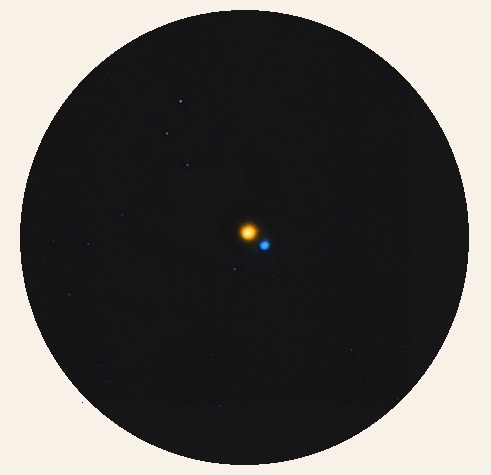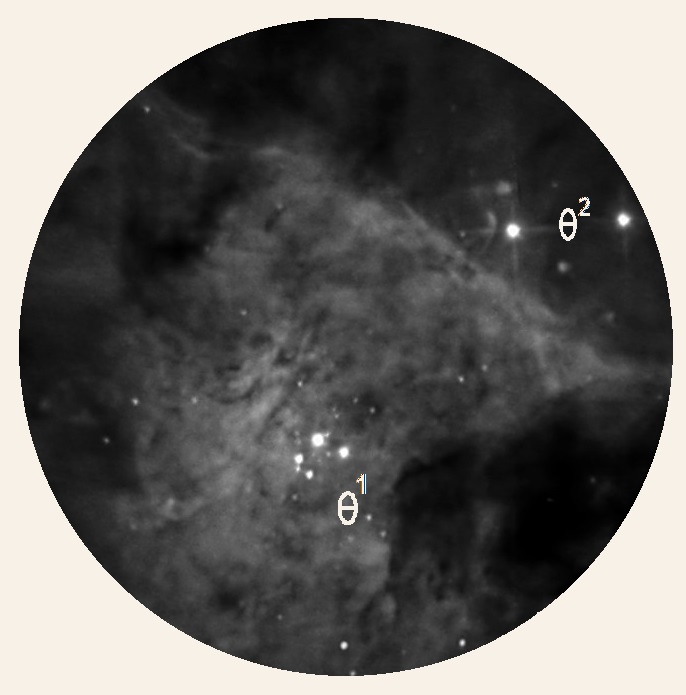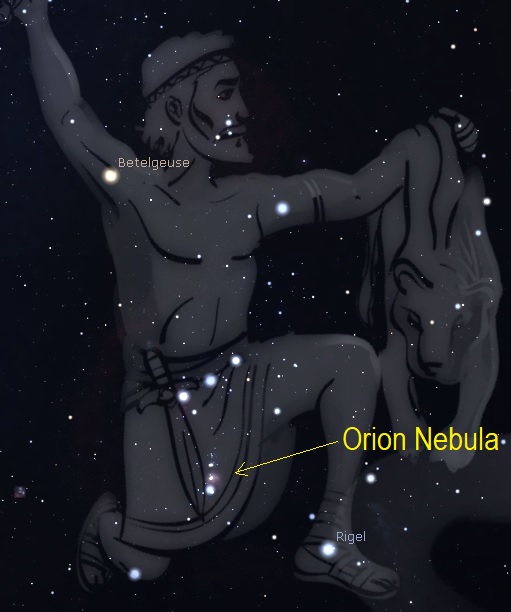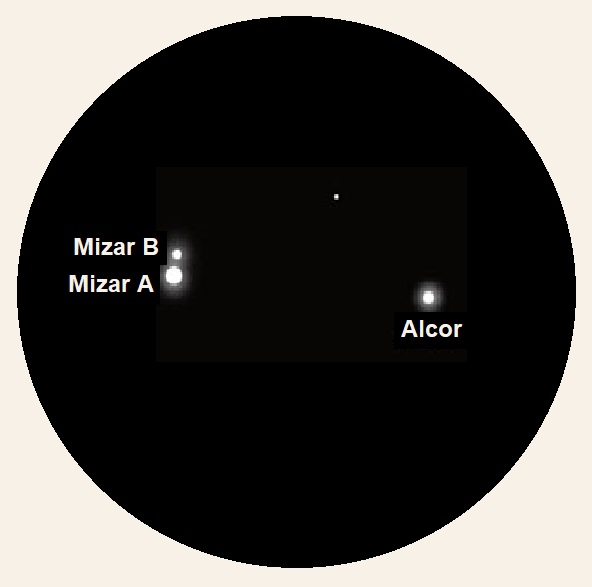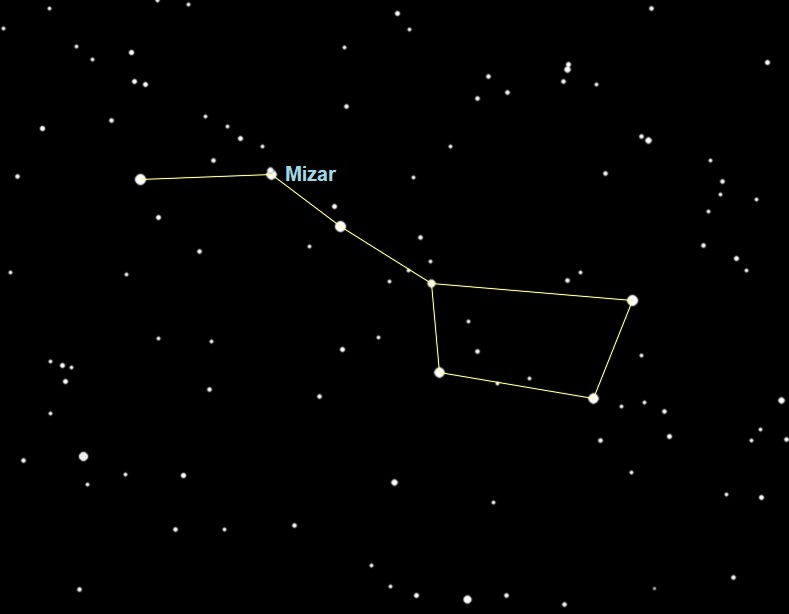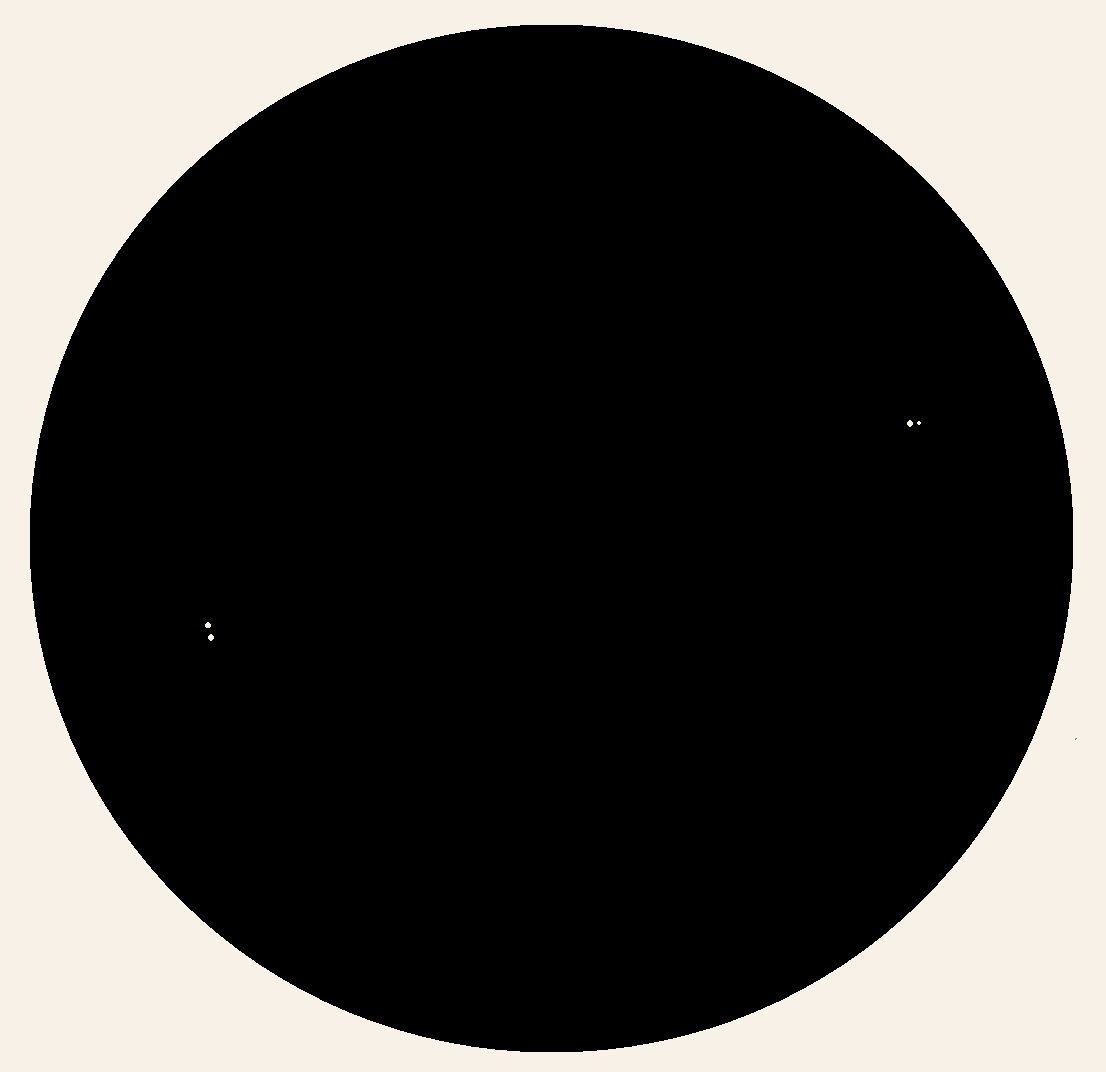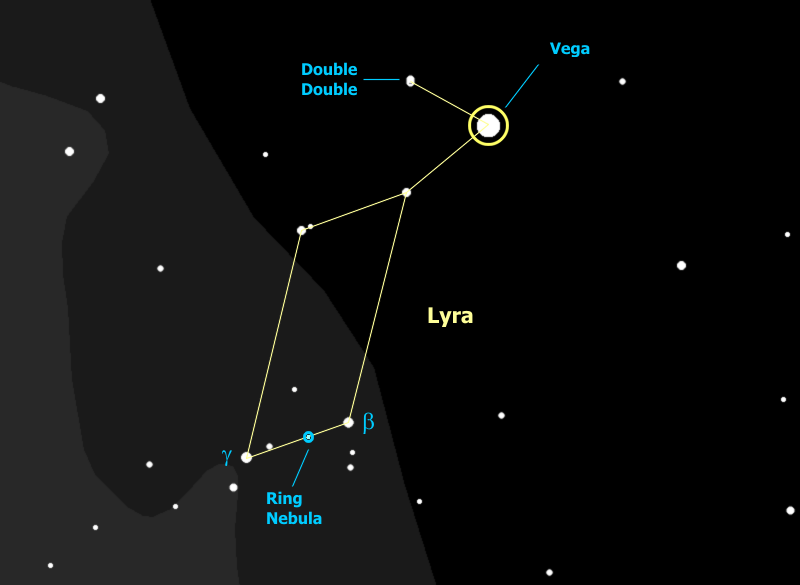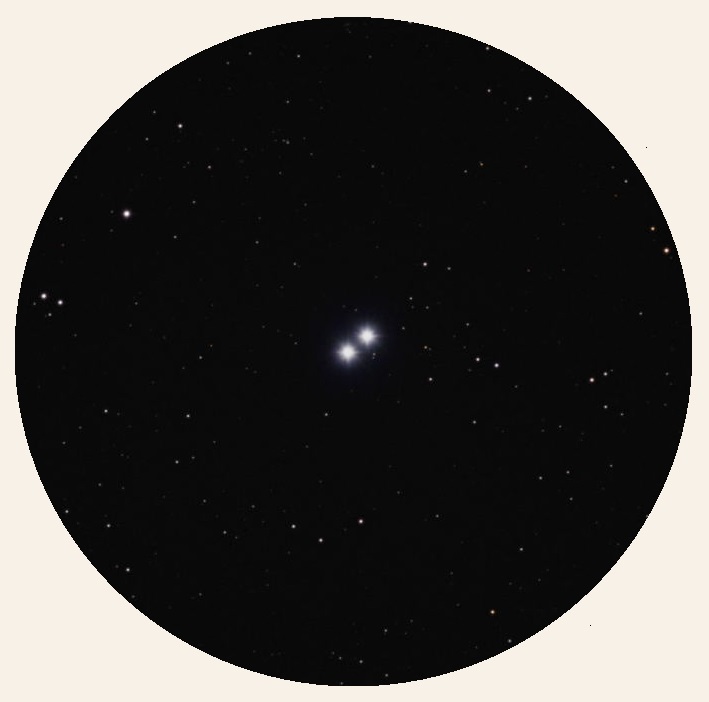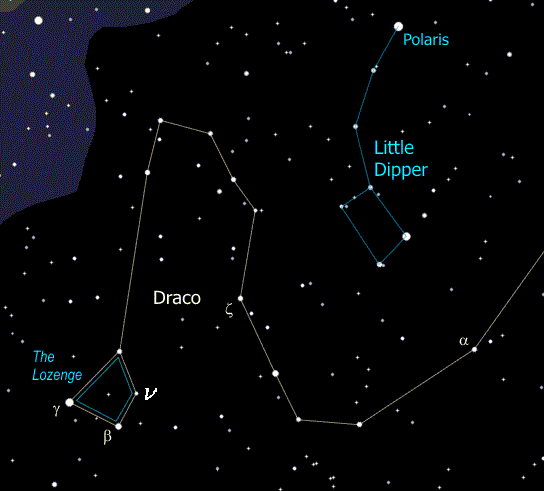Beginner's Guide
Double Stars
Many of the stars in the sky are actually binary, triple, (and more) systems. That's not immediately logical to us because we live in a solitary solar system. But most of these systems do not appear to be double (or triple, ...) simply because the stars are too close to be split by any telescope.
But the sky is still populated by many double stars which we can detect with our telescopes. Keep in mind a star may be double simply because they're in alignment with one much closer to us and the other far more distance. However, that is the fairly rare exception. Almost all the double stars we see in the sky are very close together in distance proximity.
Why Observe Double Stars?
Double stars may not seem too interesting at first, but spliting double stars is often a test of your telescope's optics and your skill as an observer. For the particularly close doubles, the astronomical seeing is going to be the limiting factor.
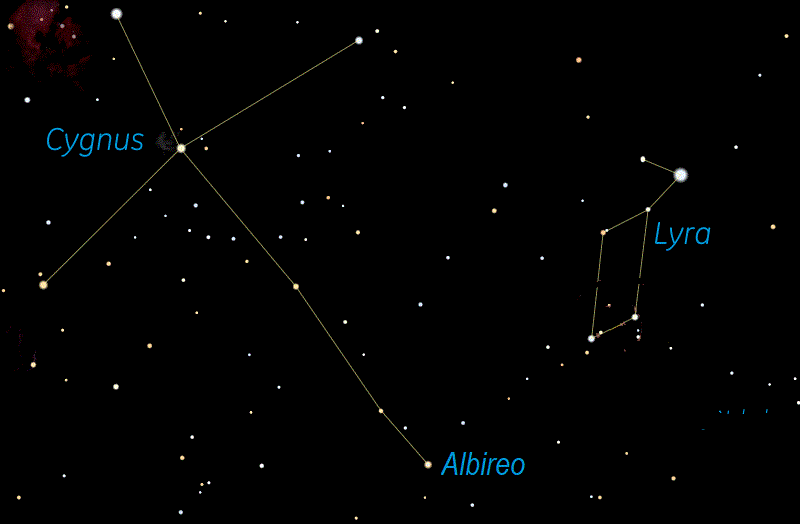 But double stars also give you a chance to see stars of different colors. Normally star colors tend to be be pretty subtle, but when you
see them side by side the contrast can be nothing short of amazing. At the right is probably the most famous contrasting double, Albireo (β Cygni).
It is often referred to as the blue-gold double.
But double stars also give you a chance to see stars of different colors. Normally star colors tend to be be pretty subtle, but when you
see them side by side the contrast can be nothing short of amazing. At the right is probably the most famous contrasting double, Albireo (β Cygni).
It is often referred to as the blue-gold double.
Albireo can be easily found as it appears as a 3.1 magnitude star in the Northern Cross which is part of the constellation Cygnus.
Splitting the Double Stars
Observing double stars is often considered a right of passage for the beginner. You can learn a lot about the performance of your telescope, mount, eyepieces, and the limits of astronomical seeing.
When going for your first double star, you should choose one no closer than 10 seconds of arc and the companion should be no fainter than the 8th magnitude.
So how much magnification will you need to split any given double? The rule in telescope optics is the true angular field of view multiplied by the magnification equals the apparent angular field of view. This rule can be applied to any part of the field. To demonstrate let's use the example of Mizar (δ Ursae Majoris), in the pan handle of the Big Dipper as the separation is 14" (14 seconds of arc) and it's both easy to find and a circumpolar star so can be seen any time of the year. The 14" of arc is the true field angle which is what you'd see with the naked-eye. Since the human eye cannot split 14" of arc so you need to magnify it. Let's use an example of 43X.
43 X 14" = 602" or about 10'
So given 43X magnification, the apparent separation is 10 minutes of arc. As you can see from the diagram below, this is above the minimum separation of 8' for comfortable viewing separation.
Please note these separations are probably not accurate because the sizes vary greatly from one computer screen to another. In order to see it correctly you should click here (or on the diagram) which will bring up a PDF which you can then print. That page should be viewed at 10 inches to give you the real separations.
For a more in-depth discussion on splitting double stars, we recommend reading this discussion on the resolving power of a telescope written by MAS member, Randy Culp.
Power Needed For Splitting Double Stars
| Sep | Example | 4' | 6' | 8' * | 12' | 20' | 25' |
|---|---|---|---|---|---|---|---|
| 1.0" | 35 Com | 240 | 360 | 480 | 720 | 1200 | 1500 |
| 1.5" | μ Cyg | 160 | 240 | 320 | 480 | 800 | 1000 |
| 2.0" | ξ UMa | 120 | 180 | 240 | 360 | 600 | 750 |
| 2.5" | α Gem | 96 | 144 | 192 | 288 | 480 | 600 |
| 3.0" | σ Cas | 80 | 120 | 160 | 240 | 400 | 400 |
| 3.5" | 17 Dra | 68 | 102 | 136 | 206 | 343 | 428 |
| 4.0" | ρ Her | 60 | 90 | 120 | 180 | 300 | 375 |
| 4.5" | γ Leo | 54 | 80 | 108 | 160 | 266 | 332 |
| 5.0" | φ2 Cnc | 48 | 72 | 96 | 144 | 240 | 300 |
| 5.5" | π Boo | 44 | 66 | 88 | 132 | 218 | 272 |
| 6.0" | σ CrB | 40 | 60 | 80 | 120 | 200 | 250 |
| 7.0" | 38 Gem | 34 | 51 | 68 | 103 | 171 | 214 |
| 8.0" | Struve 2486 Cyg | 30 | 45 | 60 | 90 | 150 | 188 |
| 9.0" | δ Her | 27 | 40 | 54 | 80 | 133 | 166 |
| 10" | γ And | 24 | 36 | 48 | 72 | 120 | 150 |
| 11" | ε Equ | 22 | 33 | 44 | 66 | 109 | 136 |
| 12" | η Cas | 20 | 30 | 40 | 60 | 100 | 125 |
| 13" | β Cep | 18 | 28 | 36 | 56 | 91 | 115 |
| 14" | Mizar | 17 | 26 | 34 | 52 | 86 | 107 |
| 15" | 19 Lyn | 16 | 24 | 32 | 48 | 80 | 100 |
| 18" | α UMi | 13 | 20 | 26 | 40 | 67 | 83 |
| 20" | α CVn | 12 | 18 | 24 | 36 | 60 | 75 |
| 23" | ζ Psc | 10 | 16 | 20 | 32 | 52 | 65 |
| 28" | 61 Cyg | 9 | 13 | 17 | 26 | 43 | 54 |
| 35" | β Cyg | 7 | 10 | 14 | 20 | 34 | 43 |
| 44" | ζ Lyr | 5 | 8 | 11 | 16 | 27 | 34 |
| 52" | φ Tau | 6 | 7 | 9 | 14 | 23 | 29 |
| 62" | ν Dra | 4 | 6 | 8 | 12 | 19 | 24 |
* 8 Minutes of apparent separation is what we recommend for easy splitting. Note on the diagram 8' is fairly visible, but 6' can be challenging and 4' is pretty difficult. 2' which is considered the bare minimum can seem almost impossible, certainly requiring the best optics and the best seeing conditions. Also: note that 25' is very near the width of the full moon as seen naked-eye.
Get Power Requirements For Custom Double Star Separations
Magnification Results: Separation = 50"
| Sep | 4' | 6' | 8' | 12' | 20' | 25' |
|---|---|---|---|---|---|---|
| 50" | 5 | 7 | 10 | 14 | 24 | 30 |
Contrasting Star Colors
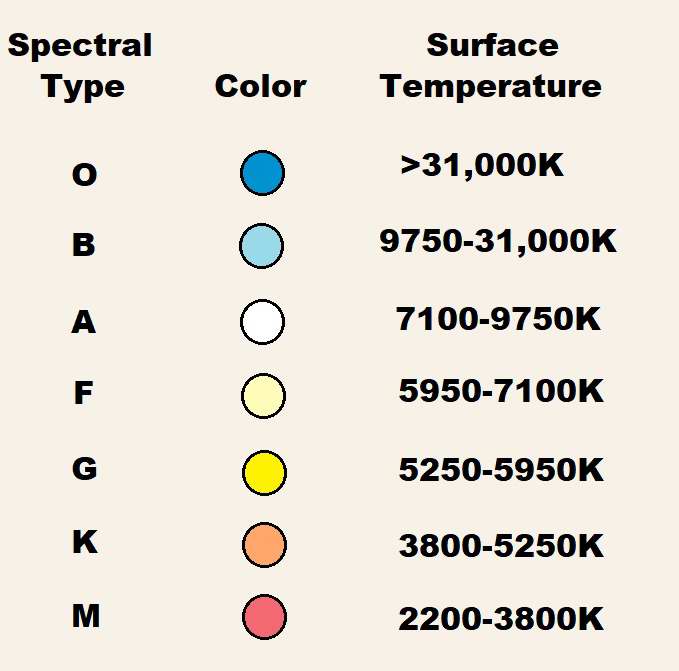 Star colors are given in astronomical catalogues by their spectra glass. The major spectra classes are: O, B, A, F, G, K, and M. Within
each of these they are further broken down with the possible numbers of 0-9. In the table below you'll see the spectra classes for the two
double stars. In the column second from the right is the Color Difference. That's simply counting the steps between the two spectra classes.
Star colors are given in astronomical catalogues by their spectra glass. The major spectra classes are: O, B, A, F, G, K, and M. Within
each of these they are further broken down with the possible numbers of 0-9. In the table below you'll see the spectra classes for the two
double stars. In the column second from the right is the Color Difference. That's simply counting the steps between the two spectra classes.
Please keep in mind that colors tend to be very subtle. However, what makes these doubles so great is that they enhance the colors because seeing them side-by-side maximizes the contrast.
| Some Contrasting Color Double Stars | |||||||||
| Star | R.A. Dec. |
Mags. | Sep. | P.A. | Color diff |
Spec. Class | |||
| η Cas | 00h 49m | +57° 49' | 3.5 | 7.2 | 12" | 317° | 1.7 | G0, K7 | |
| 1 Ari | 01h 50m | +22° 16' | 5.9 | 7.2 | 2.9" | 164° | 3.5 | K1, A6 | |
| γ And | 02h 04m | +42° 20' | 2.1 | 4.8 | 9.8" | 64° | 3.5 | K3, B8 | |
| η Per | 02h 51m | +55° 54' | 3.8 | 8.5 | 28" | 301° | 3 | K3, A3 | |
| 32 Eri | 03h 54m | -02° 57' | 4.8 | 5.9 | 7" | 254° | 2.6 | G8, A2 | |
| ρ Ori | 05h 13m | +02° 52' | 4.6 | 8.5 | 7" | 64° | 1.7 | K3, F7 | |
| γ Lep | 05h 44m | -22° 27' | 3.6 | 6.3 | 97" | 350° | 1.6 | F6, K2 | |
| h3945 CMa | 07h 17m | -23° 19' | 5.0 | 5.8 | 26.8" | 52° | 2.0 | K0, F0 | |
| ι Cnc | 08h 47m | +28° 46' | 4.0 | 6.6 | 30.6" | 307° | 2.6 | G8, A2 | |
| 24 Com | 12h 35m | +18° 23' | 5.1 | 6.3 | 20" | 270° | 2.2 | K0, A9 | |
| α Her | 17h 15m | +14° 23' | 3.1 | 5.4 | 5" | 106° | 1.7 | M5, G8 | |
| 95 Her | 18h 02m | +21° 36' | 4.9 | 5.2 | 6" | 258° | 2.3 | A5, G8 | |
| Albireo | 19h 31m | +27° 57' | 3.4 | 4.7 | 35" | 54° | 3.5 | K3, B8 | |
| 31 Cyg | 20h 14m | +46° 44' | 3.8 | 4.8 | 107" | 325° | 2.9 | K2, B3 | |
| β Cap | 20h 21m | -14° 47' | 3.2 | 6.1 | 207" | 267° | 3.2 | K0, B8 | |
| γ Del | 20h 47m | +16° 07' | 4.4 | 5.0 | 9" | 267° | 1.4 | K1, F7 | |
| δ Cep | 22h 29m | +58° 25' | 4.1 | 6.3 | 40.9" | 191° | 2.5 | G2, B7 | |
Other Notable Double Stars
Here we present some other notable double stars.
The Trapezium
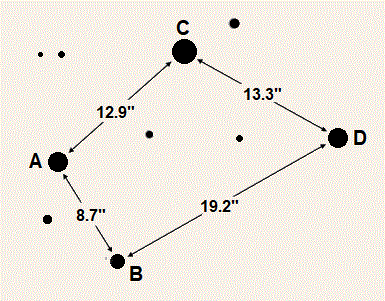 The Trapezium quadruple (it gets it's name from Trapezoid) is in the Orion Nebula. It's located
in the "sword" of Orion. The four primary stars are θ1 Orionis. If you look at most of the photographs of the Orion Nebula, you should
notice that the Trapezium is only rarely visible because the exposures are set to capture as much nebulosity as possible. But in your telescope the Trapezium
is readily apparent. The distances are shown in the diagram and the magnitudes are as follows:
The Trapezium quadruple (it gets it's name from Trapezoid) is in the Orion Nebula. It's located
in the "sword" of Orion. The four primary stars are θ1 Orionis. If you look at most of the photographs of the Orion Nebula, you should
notice that the Trapezium is only rarely visible because the exposures are set to capture as much nebulosity as possible. But in your telescope the Trapezium
is readily apparent. The distances are shown in the diagram and the magnitudes are as follows:
A = 6.7-7.7 Eclipsing Binary; period 65 days
B = 7.9-8.6 Eclipsing Binary; period 6.5 days
C = 5.1
D = 6.7
θ2 is a wide double at 52".
Mizar and Alcor
The sixth star of the Big Dipper is η Ursa Majoris, but it's proper name is Mizar. This star is actually a naked-eye double to many observers, but not everyone can detect the companion, Alcor. In binoculars or your finder scope, however, Alcor will be readily seen. In any telescope, however, you'll see that Mizar is actually a double star itself. Mizar A is the bright (magnitude 2.4) one with Mizar B the fainter (magnitude 4.0). A and B are separated by 14" so they are readily seen as separate at 40X.
The Double Double
ε (Epsilon) Lyrae is known as the double double. To the naked-eye most people can only see one star, but through binoculars or your finder scope, you can see it is a double star, separation 210". But then in a telescope are relatively high power you can see that each of these stars in turn is double. ε1 mags 5.1 and 6.0, sep 2.4". ε2 mags 5.1 and 5.4, sep 2.2".
ν Draconis
ν (Nu) Draconis is just a fun double comprised of ν1 and ν2. Both stars are magnitude 5 and they are separated by 62". They can be split by a binoculars or your 7X or more finder scope.
γ (Gamma) Andromedae
Magnitudes 2.3 and 5.1, separation 10.0 arcseconds. A stunning gold and blue pair. One of the most beautiful double stars in the entire night sky.
ι (Iota) Cassiopeiae
ι Cassiopeiae mags 4.7, 7.0, and 8.3, sep 2.5" and 7.3" A fine triple. A challenge for 3-inch scopes, because of the closeness of the mag 4.7 and 7.0 components.
β Orionis - Rigel
β Orionis (Rigel) mags 0.1 and 6.7, sep 9.4" Small scope users will have a tough time glimpsing the companion, which hides in the glare of the brilliant primary.
h3945 Canis Majoris
h3945 Canis Majoris mags 4.8 and 6.8, sep 26.6" Here's a gold and blue pair that rivals Albireo and because it's a winter object sometimes called the Winter Albireo. Absolutely beautiful!
α Geminorum - Castor
α Geminorum (Castor) mags 2.0 and 2.8, sep 4.4" A binary star that has been widening from a minimum separation of 1.8" in 1969. Now an easy sight in the smallest of scopes. Look for a 9th magnitude star 72.5" away. All three stars are spectroscopic binaries, making Castor a sextuple star!
ι Cancri
ι Cancri mags 4.2 and 6.6, sep 30.5". A springtime "Albireo" with striking gold and blue colors.
γ Leonis (Albeiba)
γ Leonis (Algeiba) mags 2.6 and 3.8, sep 4.5". Beautiful slow-moving binary; both yellow.
ξ Ursae Majoris
ξ Ursae Majoris mags 4.3 and 4.8, sep 1.6". A rapidly-moving binary system with a period of about 60 years. A good test for a 3-inch scope.
Wnc 4 Ursae Majoris - M40
Wnc 4 Ursae Majoris mags 9.0 and 9.3, sep 50". We put this on the list simply because it was clearly a mistake. Charles Messier included this in this list of M Objects and this one is designated M40.
α Canum Venaticorum
α Canum Venaticorum (Cor Caroli) mags 2.9 and 5.4, sep 19.6". One of the finest double stars in the sky for small telescopes. The Colors have been described as white and slightly yellowish.
ε Bootis - Izar
ε Bootis, Izar (magnitudess 2.7 and 5.1, separation 2.9 arcseconds) Izar's striking gold and blue colors inspired its discoverer, F. G. W. Struve, to nickname it Pulcherrima - "the most beautiful." Can be resolved in a three-inch scope, if the seeing is steady and you use 100X or more.
ξ Bootis
ξ Bootis (mags 4.8 and 6.9, sep 6.5") Binary system (Period ~ 150 years) with remarkable yellow and red colors. Closing to a separation of just 2.2" in 2064.
μ Draconis
μ Draconis (mags 5.8 and 5.8, sep 2.2") A neat twin binary star (Period = 482 years) whose separation is very slowly increasing. The two lie at the theoretical limit of resolution for the common 60mm (2.4-inch) refractor. If you attempt to "notch" μ Dra with such a scope, you'll need your highest magnification (about 120X for that aperture) and optimum seeing conditions.
γ Delphini
γ Delphini (mags 4.5 and 5.5, sep 9.6") The Dolphin's "snout." One of the finest double stars for small telescopes. You may be able to detect the pairss subtle yellow and blue colors. In the same field, ¼ degree to the southwest, is the delicate little pair Struve 2725 (mags 7.6 and 8.4, sep 5.8").
η Cassiopeiae
η Cassiopeiae (mags 3.4 and 7.5, sep 13.0") What makes this slow-moving binary pair (period = 480 years) noteworthy is its stunning color scheme - yellow for the primary star, red for the companion. Marginally visible in small instruments, the colors really stand out in a 6-inch scope.
α Ursa Minoris - Polaris
α Ursae Minoris (mags 2.0 and 9.0, sep 18.4") Polaris, the North Star. This is a classic light test for the common 60mm refractor. The 9th magnitude companion is hard to spot in the glare of the bright primary star. Easy in a 6-inch scope; shows yellow and blue colors.

